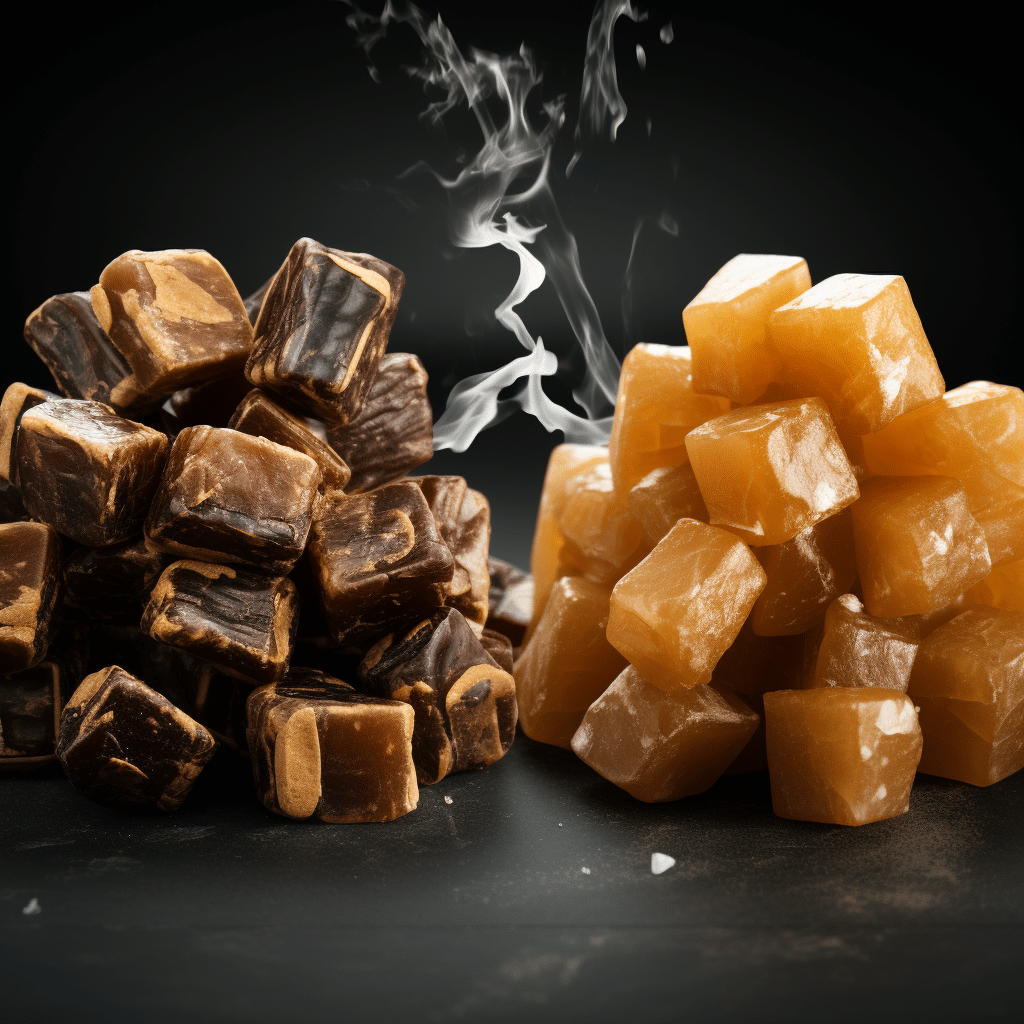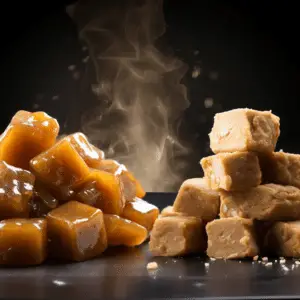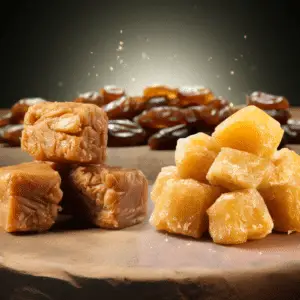
Piloncillo vs. Jaggery: Unrefined Sugar Comparison
Various Piloncillo vs. Jaggery Comparison plants such as sugar beets and sugarcane produce sugar. The plant sources are refined in the industries to remove impurities like molasses. When the refining process is minimally done, some molasses are left. Well-refined sugars don’t contain molasses.
Piloncillo is the unrefined sugar that is produced from sugarcane. On the other hand, Jaggery is also a simple sugar that undergoes a traditional processing technique similar to Piloncillo.
Piloncillo and Jaggery are non-centrifugal sugars. They are very similar and quite challenging to differentiate. Let’s discuss some slight variations between That Piloncillo vs. Jaggery.

They Piloncillo vs. Jaggery
Piloncillo vs. Jaggery: Main Differences
- Piloncillo is commonly produced in Latin America, while Jaggery is made in Africa and Asia.
- Piloncillo is made from sugarcane alone, while Jaggery can be produced from palm or sugarcane. The Palm Jaggery made from toddy palm or date palm is highly preferred but the most difficult to find.
- Piloncillo and Jaggery are typically molded into different shapes. Piloncillo is primarily available in a characteristic cone shape.
Piloncillo Overview
The Piloncillo is also called panela in Mexico. It’s made from sugarcane juice. Its color varies from light to dark based on the type of sugarcane subjected to the refining process—sugarcane plants are typically subjected to mechanical pressures and boiling. The fibers are later used as fuel and the cane juice is boiled continuously until a thick dough is formed.
When the juice is adequately concentrated, it’s poured into cone-shaped molds. That is where Piloncillo derives the famous cone shape. Either way, you can find Piloncillo in liquid form, granulated, or block shape.
Uses of Piloncillo
- Piloncillo is used in savory and sweet meals.
- Piloncillo is flavorful to be used in pastries, beverages, and sauces.
Jaggery Overview
As stated above, Jaggery is unrefined sugar like Piloncillo sourced from Africa and Asia. It’s a popular unrefined sugar in India, referred to as “gur.” Jaggery can be made from either palm or sugarcane. Therefore, the variety is available as Palm Jaggery and sugarcane Jaggery.
Now, how is Jaggery made? Jaggery and Piloncillo are made using the same technique. First, the sugarcane is cut and transported from the field to the processing units. The cane plant is subjected to mechanical or manual pressure to release sugarcane juices. For the Palm Jaggery, the producer taps sap from the palm trees.
Juices from palm and sugarcane are boiled in different large and flat pans. Moisture evaporates, and the concentrated dough is left out after some time.
The dough is poured into a container or mold and left for cooling. The final product will acquire the shape of the container used.
Uses of Jaggery
- Jaggery is used in a significant number of recipes to make award-winning dishes and is used for both savory and sweet meals.
- It can be used as a substitute for refined sugar.
- In India, Jaggery is used to produce local candies and desserts.
What Are Some of The Benefits of Jaggery?
Jaggery, a common ingredient in South Asian cuisine. It’s perfect for those who enjoy the taste of molasses or caramel.
Jaggery is the growing alternative to refined sugar. It’s the superfood sweetener called non-centrifugal sugar since it’s not subject to a spin in the refining process to remove nutritious molasses.
The molasses content makes Jaggery more nutritious than refined sugars. The nutritionally significant by-product is removed when making refined sugar. Molasses have micronutrients that are beneficial for body functions.
The nutritional profile of Jaggery varies depending on the plant used. According to some sources. 100 grams of Jaggery contain:
- 383 calories
- 65 to 85 grams of sucrose
- 10 to 15 grams of glucose and fructose
- 0.4 grams of protein
- 0.1 grams of fat
- 11mg of iron
- 70 to 90 mg of Magnesium
- 1050 mg potassium
- 0.2 to 0.5 mg Manganese
Piloncillo vs. Jaggery Comparison to the elements above, Jaggery also contains a small amount of Vitamin B, Calcium, Copper, Zinc, and Phosphorus. SugaVida found in granulated palm jaggery is a rich source of vitamin B.
The bottom line of Jaggery’s nutritional status is that it has a better nutritional profile than refined sugar but with higher calories. It’s best when consumed in moderation.
One of the reasons that have made Jaggery rise in popularity is because of its wide range of health benefits. Jaggery’s expected benefits include anemia prevention, improved immunity status, good digestive health, and liver detoxification.
The problem with jaggery is that it may make you more likely to get type 2 diabetes, heart disease, and be overweight. In the end, it’s a better choice than pure sugar because the unremoved molasses gives it more nutrients.
Jaggery Alternatives
If you can’t get palm or sugarcane Jaggery at the local supermarket, keep baking and creating that delectable dish your child likes to eat. Choose the proper Jaggery replacement from the list below, then make yourself a fragrant beverage.

Best Alternative to Jaggery
The best replacement for Jaggery is dark brown sugar. Piloncillo, molasses, agave nectar, Muscovado sugar, demerara sugar, honey, and maple syrup are other alternatives with excellent nutritious substitutes.
Dark Brown Sugar
The first choice you should consider if you need to replace Jaggery is dark brown sugar. Its color is identical to that of Jaggery, yet unlike wide varieties of sugar, it’s healthier. 1 1/4 cups of dark brown sugar can be used instead of 1 cup of Jaggery.
Piloncillo
Piloncillo sugar, sometimes called panela, contains little to no additions. You may use it in place of Jaggery in your morning coffee to make it healthier.
Molasses
Molasses makes an excellent Jaggery alternative if your recipe needs a dark tint. It has a strong flavor,therefore, it should be used in smaller amounts than Jaggery.
Agave Nectar
When you cannot locate the Jaggery lump for your iced tea, agave nectar is the go-to ingredient. Additionally, it may be used to make various unique drinks without sacrificing flavor.
Maple syrup
To offer the special menu or a delicious twist in flavor, maple syrup may also be utilized as a replacement for Jaggery in various dishes like oatmeal cookies, coffee, or tea.
Muscovado Sugar
Since it’s created from refined or unrefined sugar that contains molasses, Muscovado sugar is a delicious alternative to Jaggery. Muscovado, which comes in dark and light varieties, can replace Jaggery in drinks and curries.
Sugar Demerara
Demerara sugar is a deep type that comes in crystal form, giving your dish a crisp feel. It may be substituted for Jaggery while preparing tea and coffee, as well as for baking.
Honey
Piloncillo vs. Jaggery Comparison to serving as a Jaggery alternative, honey may also serve as a terrific energy booster.